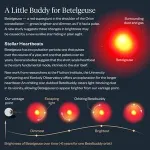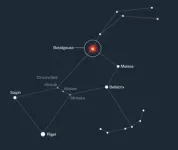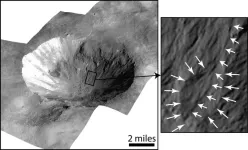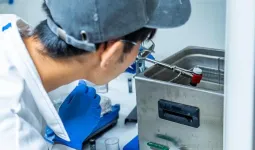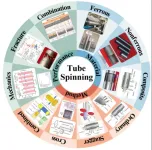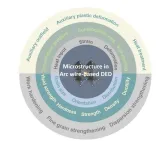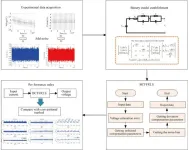(Press-News.org) A device that delivers direct stimulation to the brain was found to be a safe and effective means of treating depression at home, according to a new study by researchers at UTHealth Houston; the Institute of Psychiatry, Psychology & Neuroscience at King’s College London; and the University of East London.
The research was published in Nature Medicine on Oct. 21, 2024.
Transcranial direct current stimulation (tDCS) is a form of noninvasive brain stimulation that applies a weak, direct current of between 0.5 to 2 milliampere to the scalp via two electrodes. It is already commonly used in clinics to treat conditions such as psychosis and eating disorders. The clinical trial assessed tDCS that was used in a home setting and self-administered by patients.
King’s College London led the international study. Co-author and lead investigator for the U.S. site was Rodrigo Machado-Vieira, MD, PhD, MSc, professor with the Louis A. Faillace, MD, Department of Psychiatry and Behavioral Sciences in McGovern Medical School at UTHealth Houston.
“The results from this study, which tested home-based tDCS, may represent an important advance in the mood disorders field for improving feasibility and therapeutic response with this new neuromodulation modality,” Machado-Vieira said. “These latest results confirmed a positive profile for safety and efficacy similar to early studies with patients with depression and bipolar disorder, and the home-based therapy may facilitate access of this treatment to a larger number of patients.”
The study included 174 adult participants with a diagnosis of severe to moderate depression. They were randomly assigned to one of two treatment arms: active tDCS or inactive tDCS, which used the same device but did not provide a current. Participants had a 10-week course of treatment, with five 30-minute sessions a week for the first three weeks, followed by three 30-minute sessions a week for the following seven weeks.
Researchers found that participants in the active arm of the trial showed significant improvements in the severity of their depression, as well as an overall clinical response and remission, compared to those in the inactive placebo control arm. The rates of treatment response and remission were three times higher in the active treatment arm compared to the placebo arm, with 44.9% in the active arm demonstrating a remission rate compared to 21.8% of the control group.
“The burden of depression is mostly keenly felt by the 280 million people worldwide currently managing symptoms. While a combination of antidepressants and therapy generally proves to be effective for many people, medication can have side-effects that some can find disruptive. Our study has demonstrated that tDCS is a potential first-line option that could help those in need,” said Cynthia Fu, MD, PhD, the study’s senior author and a professor of affective neuroscience and psychotherapy at King’s College London.
“There is no such thing as the perfect medical intervention. Medication can have unintended side effects, while therapy is both time- and resource-intensive. Our hope is that tDCS can provide a viable third alternative for people with moderate to severe depression to help them better manage their symptoms,” said Rachel Woodham, MSc, the study’s first author and a research assistant at the University of East London.
“This breakthrough publication crowns the eight years of work that has been done by the fantastic team at Flow and the team of researchers at King’s College London, UTHealth Houston, and the University of East London, who led the study. Nature Medicine is one of the top medical journals in the world, and this publication speaks to the quality of the study design and results. Our core mission was, and still is, to create a treatment that is effective, safe, and accessible to as many people as possible,” said Daniel Månsson, chief clinical officer and co-founder of Flow Neuroscience, which funded the study.
UTHealth Houston co-author and co-lead investigator for the U.S. site was Jair Soares, MD, PhD, professor and the Pat R. Rutherford, Jr. Chair in Psychiatry in the Louis A. Faillace, MD, Department of Psychiatry and Behavioral Sciences at McGovern Medical School.
“The study results bring promise that an innovative treatment modality may become available for patients suffering from mood disorders some time in the near future,” Soares said.
END
At-home brain stimulation for depression is safe and effective, according to research from UTHealth Houston, King’s College London, and University of East London
2024-10-21
ELSE PRESS RELEASES FROM THIS DATE:
A 37% drop in overdose deaths from drugs mixed with opioids – fentanyl included
2024-10-21
COLUMBUS, Ohio – Expanded treatment options, increased naloxone distribution and targeted education campaigns likely led to a 37% reduction in overdose deaths from opioids combined with stimulant drugs other than cocaine, according to the results of a large federally funded study.
The finding came from a planned study of secondary outcomes of the HEALing (Helping to End Addiction Long-Term) Communities Study (HCS), which tested an intervention encompassing data-driven adoption of evidence-based practices for reducing overdose deaths in Kentucky, Massachusetts, New York and Ohio.
Death rates from specific combinations of ...
Research spotlight: Investigating strategies to help clinicians and patients navigate prescription costs
2024-10-21
Hussain S. Lalani, MD, MPH, MSc, of the Division of Pharmacoepidemiology and Pharmacoeconomics at Brigham and Women’s Hospital, is the lead author of a paper published in JAMA, “Strategies to Help Patients Navigate High Prescription Drug Costs.”
How would you summarize your study for a lay audience?
Prescription drugs can be expensive for patients, and many clinicians do not know how to respond when costs are too high. We reviewed the benefits and limitations of seven strategies that clinicians can use to help their patients navigate high-prescription drugs. These include co-payment cards, patient assistance ...
Betelgeuse Betelgeuse? Bright star Betelgeuse likely has a ‘Betelbuddy’ stellar companion
2024-10-21
The 10th-brightest star in the night sky, Betelgeuse, may not be on the brink of exploding as a supernova, according to a new study of the star’s brightening and dimming. Instead, recent research shows that the observed pulsing of the starlight is probably caused by an unseen companion star orbiting Betelgeuse.
Formally named Alpha Ori B, the “Betelbuddy” (as astrophysicist Jared Goldberg calls it) acts like a snowplow as it orbits Betelgeuse, pushing light-blocking dust out of the way and temporarily making Betelgeuse seem brighter. Goldberg and his colleagues present their simulations of this process in ...
SwRI and JPL co-led study offers insights into mysterious features on airless worlds
2024-10-21
SAN ANTONIO — October 21, 2024—A Southwest Research Institute researcher collaborated with a team at NASA’s Jet Propulsion Laboratory to attempt to explain the presence of mysterious flow features that exist on the surfaces of airless celestial bodies, such as the asteroids Vesta and Ceres, explored recently by the NASA Dawn mission, or Jupiter’s moon Europa, which will soon be explored in detail by the NASA Europa Clipper mission that includes SwRI’s involvement.
In a new paper published in The Planetary Science Journal, its lead author, SwRI’s Dr. Michael J. Poston, and a team of researchers outline how post-impact conditions, ...
Artificial ‘nose’ can sniff out damaged fruit and spoiled meat
2024-10-21
Although smell has historically played an important role in the fight against diseases such as the plague and tuberculosis, the human nose is generally not sensitive enough to be used as a reliable diagnostic tool.
However, a new artificial ‘nose’ inspired by our sense of smell could now make it possible to detect undiagnosed disease, hazardous gases, and food that is starting to spoil.
And it is all made possible with technology that already exists.
Surrounded by antennas
What do your mobile phone, computer and TV have in common? Antennas.
“We are literally surrounded by technology that communicates using antenna technology,” said Michael ...
Tube spinning process: Recent advances and challenges
2024-10-21
Amidst the sustainable evolution of the economy and society, the issues of energy scarcity and environmental degradation have gained increasing prominence, making energy conservation and emission reduction the focal point of societal concern. Within this context, metal tubes fittings, as essential components, wield significant and extensive influence in domains such as aviation, aerospace, and new energy vehicles. Notably, the burgeoning prominence of advanced plastic forming methods, epitomized by the flexible medium forming process of tubes, has garnered ...
Enhancement of material microstructure and properties in Arc wire-based direct energy deposition: A short review
2024-10-21
In recent years, additive manufacturing technology has attracted considerable attention from various stakeholders. Among the different techniques, Arc wire-based direct energy deposition (DED) has experienced a notable increase in development, offering compelling advantages such as cost-effectiveness and high forming efficiency. However, a high deposition rate results in extremely high heat input and temperature inhomogeneity, leading to a deterioration in surface quality, a reduction in material properties, an increase in residual stresses and even distortion and cracking. Consequently, the current research agenda is focused on developing methods to ensure the quality ...
Cloud computing captures chemistry code
2024-10-21
RICHLAND, Wash.—Some computing challenges are so big that it’s necessary to go all in. That’s the approach a diverse team of scientists and computing experts led by the Department of Energy’s Pacific Northwest National Laboratory, along with colleagues from Microsoft and other national laboratories and universities, are taking to democratize access to emerging cloud computing resources.
The effort, outlined in a recent peer-reviewed journal publication, provides a road map to moving scientific computing resources into a sustainable ecosystem that evolves as ...
Novel electrothermal model enables co-estimation of SOC and SOT
2024-10-21
For the main energy storage system for EVs, Li-ion batteries are extensively applied owing to their excellent overall performance The safe and efficient operation of the electric vehicle significantly depends on the accurate state-of-charge (SOC) and state-of-temperature (SOT) of Lithium-ion (Li-ion) batteries. A recent breakthrough study presented by researchers from the Tongji University and Chongqing University introduces a co-estimation of state-of-charge and state-of-temperature for large-format lithium-ion batteries based on ...
Advanced online method for battery model parameter identification: Bias-compensated forgetting factor recursive least squares
2024-10-21
Lithium-ion power battery technology stands out as a pivotal component in advancement of new energy electric vehicles (EVs). Battery parameter identification, as one of the core technologies to achieve an efficient battery management system (BMS), is the key to predicting and managing the performance of Li-ion batteries. A recent breakthrough study presented by researchers from Hebei University of Technology proposes an online battery model parameters identification approach based on bias-compensated forgetting factor recursive least squares. This advanced method is expected to improve the accuracy of parameter identification under different noise.
The ...

